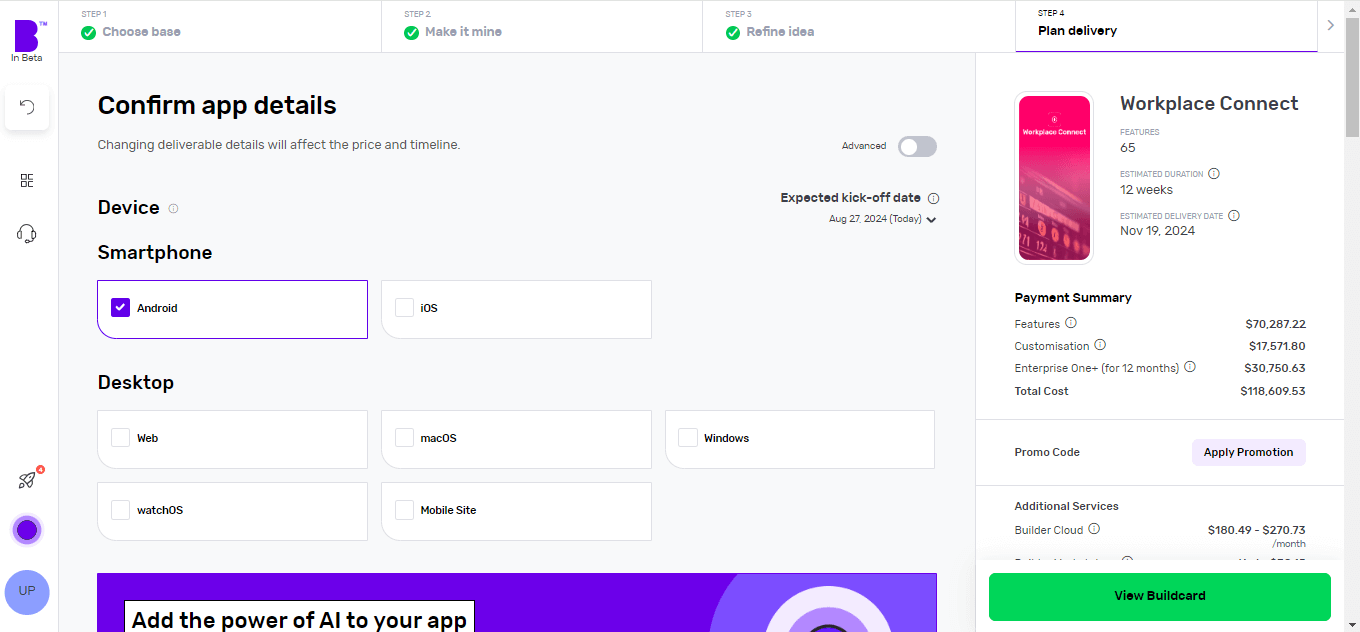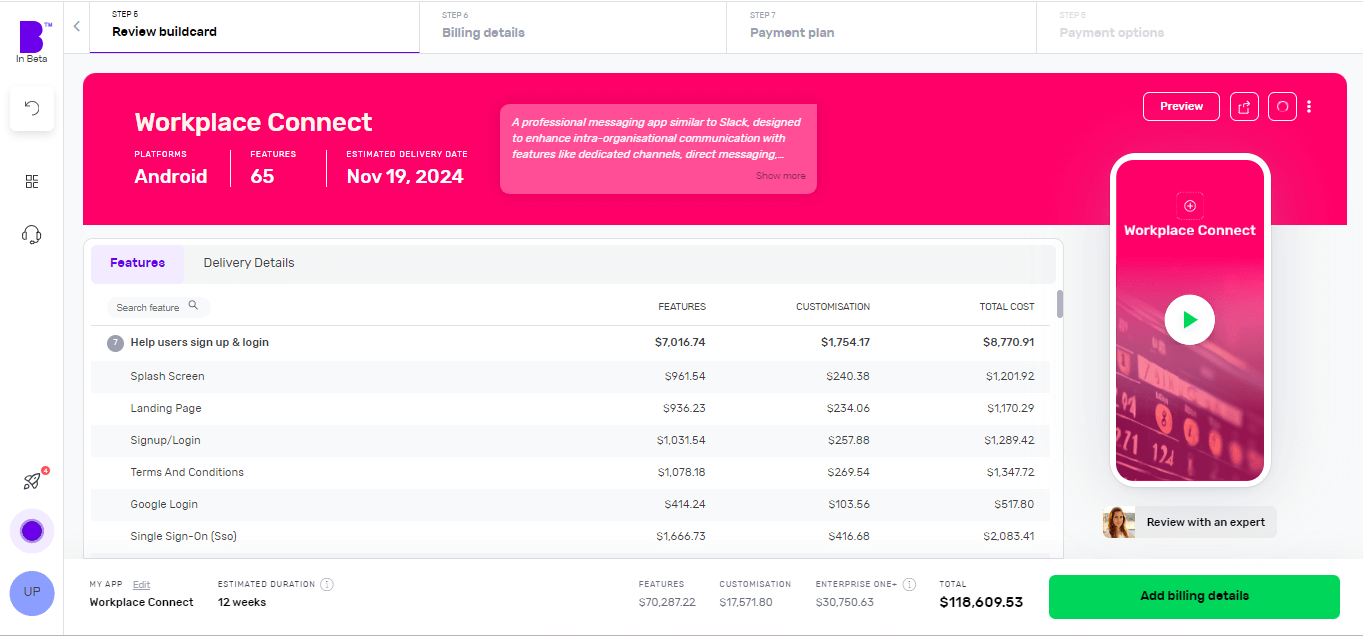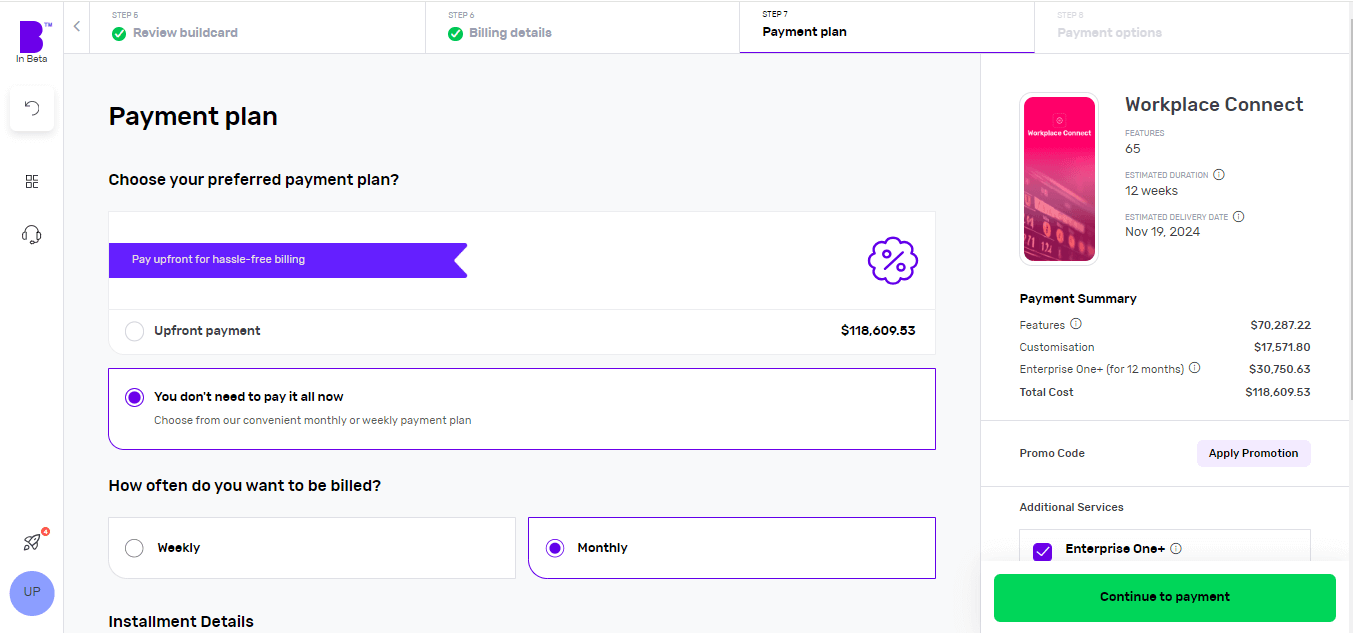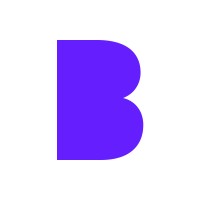Slack streamlines communication in professional setups. It lets you communicate in real-time, share files and integrate other other work apps.
Slack has 35 million daily active users and serves over 1 million organisations worldwide. Furthermore, it offers more than 2,000 integratable workspace apps in its app directory, significantly enhancing its functionality.
But even with its high demand and usage, Slack has some downsides which competitors can capitallise on.
For example, Slack users have complained of performance lags due to the sheer volume of messages and notifications as an account gets linked to multiple channels.
Small businesses who can't afford the platform's paid plans may also find the free plan restrictive, especially as they grow.
Building an app that solves these problems could be extremely profitable.
In this guide, we'll look at the main features your professional messagingapp needs and explain how you can create one using our platform.
What is a professional messaging app?
A professional messaging application is a digital tool designed for business communication. It supports messaging, file sharing and integrates with other project management and meeting platforms. These platforms enhance collaboration and are especially important for remote or hybrid work environments.
Professional messaging apps are here to stay
Messaging apps are around $100 billion industry. Some of these apps have firmly established themselves in the modern workplace — facilitating instant communication and collaboration, breaking down traditional barriers of time and location.
This evolution in workplace communication boosts efficiency and fosters a more connected and engaged workforce. So, as businesses continue to adapt to dynamic market conditions and technological advancements, the role of professional messaging apps is likely to expand, making them a permanent fixture in the way organisations operate.
Types of professional messaging apps
Here’s an overview of different types of professional messaging applications…
Team collaboration apps
These apps are built to enhance teamwork by offering features like group chats, task assignments and project tracking. Prominent examples omc;ide Slack, Microsoft Teams and Asana.
Enterprise messaging systems
Enterprise messaging offers extensive administrative controls and advanced security features. Apps like IBM Connections and Microsoft Yammer support users across different departments and geographical locations.
Customer communication platforms
These applications enable direct communication between businesses and clients by including features like chatbots, automated responses and integration with customer relationship management (CRM) software.
Zendesk and Intercom are popular choices that help manage customer interactions efficiently, providing support through messaging and tracking customer queries.
Secure messaging apps
These apps provide end-to-end encryption, which is suitable for industries that handle sensitive information, such as finance and healthcare. For example, Signal and Wickr offer secure and confidential communication.
Unified communications apps
These applications consolidate various forms of communication into a single platform, including messaging, voice calls, video conferencing and email. Platforms like Cisco WebEx and Avaya reduce the need to switch between multiple tools.
Must-have features of a professional messaging platform
A professional messaging platform should be equipped with a range of features that enhance communication, collaboration and productivity within an organisation. Here are some of the key ones you should include in your app 👇
Real-time messaging
The core functionality of any messaging platform is to enable instant communication. This ensures that your users are able to send and receive messages in real-time, facilitating quick exchanges of information.
Group chats
This feature helps users to organise conversations around specific topics, projects or departments, making it easier to keep relevant team members in the loop.
File sharing and integration
Your professional messaging platform should integrate with popular cloud storage services — like Google Drive, Dropbox and OneDrive, allowing seamless access and management of documents, images and other files.
Search functionality
Efficient search tools are necessary to find past conversations, files and specific information within chats — making it easy for your users to refer to previous discussions and materials.
Voice and video calls
Integrated voice and video calling help facilitate more personal and direct communication, especially in a remote or hybrid work environment. This feature supports one-on-one calls as well as group meetings on your app.
End-to-end encryption
Security is paramount in a professional context to protect sensitive information from unauthorised access, ensuring that messages are only readable by the sender and the recipient.
Notification controls
Users can customise notifications to avoid being overwhelmed by non-essential alerts. This includes settings for muting certain conversations, adjusting notification sounds and setting up DND modes.
User and access management
Admin controls for managing access and permissions are essential, especially for larger organisations. This shall help admins add or remove users, assign roles and control access to various parts of the platform.
Mobile and desktop compatibility
Your professional messaging app will work seamlessly across all devices, including smartphones, tablets and desktop computers, ensuring that team members can communicate effectively from anywhere.
Who should you choose to build your professional messaging platform?
There are many ways you can create a professional messaging platform. If you’re a programmer, you could create one yourself, but this might take a while. After all, complex professional messaging apps are made up of hundreds of thousands of lines of code.
Alternatively, you can hire a team of mobile app developers, who can build sophisticated, custom professional messaging software. However, the challenge here is to accurately calculate the total cost of app development.
They often charge on an hourly or daily basis, and once you factor in the costs of app development, design, app testing and listing, your expenses can quickly spiral out of control.
No-code app builders are a simpler, more budget-friendly solution. You don’t need coding skills to use them and you can build apps quickly by dragging and dropping pre-made components.
However, no-code platforms may lack the flexibility to add complex features or unique customisations. Scaling your app as your user base grows may also be challenging due to performance limitations.
This is where Builder.ai comes in. 👇
Want to start your app project with us?
Book a demoSpeak with one of our product experts today.
By proceeding you agree to Builder.ai’s privacy policy and terms and conditions

Why Builder.ai is different
Builder.ai bridges the gap between these different app development routes.
Our platform provides the customisation and scalability of professional developers along with the efficiency and cost-effectiveness of no-code builders, making it an ideal choice for developing your professional messaging app.
Around 80% of all software is made up of around 650+ features. We package each basic feature as a reusable Lego-like block. Explain your idea to our AI companion, Natasha, and she uses these blocks to rapidly create an outline of your app.
Because Natasha handles all the repetitive coding, we can complete tasks faster and cheaper. Then it’s off to our app design team and mobile app developers. They personalise it and create any bespoke elements you need.
To build your professional messaging platform, simply head over to Builder Studio. The Builder Studio platform has been built with user convenience in mind and intuitively guides you through the app creation process.
Let’s dive in with the step-by-step process 👇
1 - Discuss your ideas with Natasha

On Builder Studio, you’re greeted by Natasha. You can express your professional messaging app ideas to Natasha via voice, text or uploading a PDF or doc file.
Before you chat with her, have a checklist of app features and be as descriptive as possible about your app idea. The more detailed information you give to Natasha, the better her suggestions will be.
For example, a prompt could look like this:
"I want to develop a professional messaging app similar to Slack, to enhance communication within organisations. The app should include features such as dedicated channels for different teams or topics, direct messaging capabilities and integration with various productivity tools.
It should also support file sharing, a searchable message history, and customisable notifications to improve user engagement and collaboration efficiency. Additionally, the app must offer robust security measures to protect organisational data.
To generate revenue, the app should include options for in-app purchases and premium subscription models that provide additional features or enhanced capabilities."
Based on your prompt, Natasha will ask you some supporting questions and you simply need to answer them based on your requirements.
2 - Choose a base

Once Natasha has your requirements, she’ll create a custom framework for your app based on everything you tell her. She'll also suggest some pre-built bases she thinks are best suited for your app.
For instance, once you tell her to create an app like Slack, she’ll suggest a custom base similar to Slack and share any matching core bases as well.
You can choose up to 3 you feel are related to your big idea by simply clicking the ‘+’ icon. These selections make it easier for us to understand the features your app needs. When you’re ready, click 'Next'.
3 - Make it mine

The 'Make it mine' step aligns your app with the identity of your brand. In this step, you choose the name of your app, select its colour scheme using the colour wheel and upload the logo of your brand.
If you already have a website, you can add the link and Builder Studio will automatically pick your brand’s colours and logo.
Once you’ve personalised your app’s name, colour and logo, you can click ‘Next’.
4 - Refine your app idea

Now comes the fun bit.
In the 'Refine idea' stage, you can review and customise your app journeys and features and also create an instant prototype of your app.
Journeys
In only a matter of seconds, Natasha creates app user journeys with corresponding features.
Go through these journeys carefully and see if your app needs additional journeys. For instance, check if you want to add journeys for monetisation, sending notifications or any other relevant journey.
To add journeys, click on 'See more suggestions'. Doing so will open the list of pre-built journeys. You can browse the list and select the journeys you’re missing. You can also add custom journeys by clicking on 'Add custom journey'.
Features
By clicking on individual journeys, you can see the feature list each journey contains. Doing so will open the feature list each journey contains. You can scroll through the feature list and check if a journey contains non-essential features or if you want to add extra features.
To remove a non-essential feature, you can hover over the feature and click ‘Remove’. This way you can manage project costs. If you’re not sure what features to remove, you can click on an individual feature and check the label at the top. We highly recommend keeping the ‘Essential Features’.
In case you want to add more features, you can simply click the ‘+’ button. Here you can go through different categories or use the search bar to look for missing functionality. In case you don’t find the feature you’re looking for, you can also add a custom feature by clicking on 'Add custom feature'.
Instant prototype and user flow
Once you’re happy with the journeys and features of your app, you can create a prototype by clicking on 'Preview your app' in the top-right corner.
Sign up and Natasha will create a working prototype of your app. You can click on the screen at different areas to progress through the journey.
You can also see the user flow by clicking on the 'Flow mode' at the top of the screen to see how users will interact and navigate within your app.
If you need extra help, Natasha is on hand to help.and you can interact with her at any time by clicking on 'Speak to Natasha'.
She’ll provide you with suggestions and help you find features or journeys from the library. Or you can click on 'Book a demo' to talk to our product managers who’ll guide you through your app development journey.
Click on 'Save & Continue' to go to next step.
5 - Plan delivery

It’s time to choose the platforms you want your professional messaging app to be available on. You can choose Android, iOS or develop for both platforms simultaneously.
Next, you can choose to add Natasha to your platform to supercharge the customer experience of your professional messaging app. Natasha uses Large Language Models (LLMs) to engage your customers in fluid, human-like conversations.
In the development speed section, you can change the speed of each phase according to your needs. The faster the development speed, the higher the costs and vice versa.
Next up is Design. If you have your app designs ready, you can save your costs by clicking 'You have design' and we’ll reduce your costs accordingly. You can share your design files (preferably in Figma) and our designers will upload them, so you can kick off straight away.
If not, you can choose the 'We do your designs' option. Here, you simply need to add your brand assets and we'll do everything from storyboarding to fully designed screens.
Now it’s time to plan the phases of your project. Here you get 3 options:
- Clickable prototype: you’ll get a visual representation of your app to test with users
- Basic build: you’ll get an MVP (Minimum viable product) – a hard-coded but simplified version of your idea — this allows you to collect feedback and iterate before you do a full build
- Full Build: you’ll get market-ready software, including a kick-off with our product team and review sessions
After that, you need to select your support plans. With 'Full Build' you get one year of Studio One support included free of charge.
Once you’ve planned your delivery, click on 'View Buildcard'.
6 - Review Buildcard

Buildcard provides you with a bird's eye view of all the selections you made in the previous steps. Here, you can review all the features, cost per feature and delivery details.
You can also download the PDF of Buildcard or invite others to show your team members what you’re building.
If you want to make any changes, simply click on 'Edit Buildcard' under 3 dots in the top-right corner
If you’re happy with everything, click on 'Add billing details' to go to the next section. Alternatively, if you want to review it with experts, click on 'Review with an expert'.
7 - Select your payment plan

We offer weekly or monthly payment instalments, with visible payment dates and amounts for each option. You can also choose to pay upfront to reduce the cost of your build.
Simply select your preferred billing cycle, then click 'Continue' to proceed.
You’ll be asked to input your payment details and agree to the terms and conditions. Once that’s done, click 'Continue to Payment'.
Once your payment is done, you can set up a meeting with our product managers to begin your app development.
8 - Monitor your app build in real-time
With Builder Home, your real-time project dashboard, you can monitor development progress and make sure your app is exactly the way you want it.
This includes access to a suite of collaboration tools to help improve your app design. You can chat with your team of experts in Builder Meet, brainstorm in Builder Whiteboard and visualise your ideas with free Tailor-made prototypes from Builder Now.
Conclusion
While professional messaging apps like Slack have revolutionised how we manage our communication within an organisation, they also have their own set of challenges.
Creating your professional messaging app isn't just about entering a competitive market — it's about better serving the diverse needs and preferences of the audience.
With the right features and a user-centric approach, your professional messaging platform can provide a refreshing alternative to the industry giants.
Hit the banner below and kick off your professional messaging app project with us today 👇
Want to start your app project with us?
Book a demoSpeak with one of our product experts today.
By proceeding you agree to Builder.ai’s privacy policy and terms and conditions

Stories published by the editorial team at Builder.ai.










 Facebook
Facebook X
X LinkedIn
LinkedIn YouTube
YouTube Instagram
Instagram RSS
RSS


